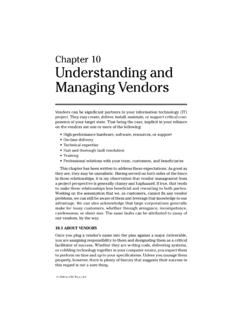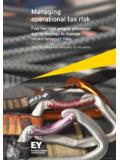Transcription of Managing Needle Blight in Leyland Cypress Revised
1 Managing Needle Blight in Leyland Cypress Unedited NCSU Christmas Tree Note Draft To Be Reviewed Leyland Cypress has quickly grown in popularity on choose n cut farms throughout the south and has eclipsed production of many more traditional species such as Virginia pine and white pine in some areas. Leyland Cypress is prone to several fungal diseases including Seiridium canker, Botryosphaeria canker, Needle Blight , and several root diseases. The canker and foliar diseases can be spread through cultivation practices such as shearing damp infected trees, which can spread spores of the fungus to other trees resulting in potentially significant damage and financial loss for growers. In site surveys for disease on farms in North Carolina, only Needle Blight was found on a regular basis and Georgia growers recently identified it as their most significant cultivation issue.
2 Many growers have experienced mild to severe infection on their Leyland Cypress , and in some cases trees had to be destroyed. The name of this Needle Blight pathogen has changed several times there is evidence that it may be caused by more than one fungus. Passalora sequoiae is the current pathogen name. Earlier names included Cercospordium, Cercospora, and Asperisporium. Historically, disease management recommendations for controlling Needle Blight involved the application of foliar fungicides applied when new growth was emerging and continuing at regular intervals throughout the entire growing season. Few growers are able to maintain or can afford, such a rigorous treatment regime. However, close observation of spore production over the growing season and treatment trials at several North Carolina farms have demonstrated that Needle Blight can be managed such that damage to foliage is light.
3 If treatments are applied early, limiting the number of new infections, infected tissues may even green up before the end of the growing season. Additional fungicide applications in mid-summer may be necessary to treat any new infections that develop. Needle Blight is capable of causing new infections on the tree throughout the growing season. In the spring (about mid-May to mid June), fungal spores are produced on needles and secondary lateral branches that were infected the previous year. The spores are then windblown or splashed by rain or carried by shearing tools to multiple new sites within the same tree or neighboring trees. Reddish-brown lesions of dying tissue develop on infected twigs. Infected needles turn yellow and eventually brown (usually observed in August-September).
4 The fungus will reproduce inside these lesions and infected needles by producing more spores. These spores are then capable of causing another round of new infections on the tree. Spores also continue to be produced in the older lesions, in turn causing more new infections. This results in a snowball effect of spore production, leading to high populations of the fungus by mid summer. The production of spores continues into November, but whether or not these spores are causing new infections this late in the season is unknown. There is a delay between when infection occurs, and the development of visual symptoms on the tree. Although we do not know for certain how long it takes from infection to symptom expression, observation suggests that it takes about two months for tree symptoms to develop.
5 In other words, new lesions that appear in August are most likely from infections that occurred back in June. The key to successfully Managing this disease is to limit the number of new infections in the spring, thereby reducing the population of spores and new infections later in the summer. This is done by carefully scouting the trees beginning in mid-May, looking for signs of fungal sporulation on old, infected tissue from last season. Fungicide applications should be initiated when sporulation is first observed. This process is repeated again in early to mid August, scouting old infections, as well as looking for new lesions that have developed in the current season. Confirming the Presence of Needle Blight : Symptoms visible without magnification: Passlora Needle Blight usually first infects the interior lower foliage and with time spreads both outwards and upwards.
6 For early symptoms, look first for discoloration on lower branches. Symptoms can range from yellowish to reddish to brown foliage and on severely-infected branches foliage loss. Figure 1. Early signs of Needle Blight on lower branches. Mostly yellowing and tips still green. Figure 2. Symptoms of more advanced infestation including some loss of foliage. In general terms, symptoms include: defoliated secondary lateral branches and tan to reddish-brown areas (lesions) along with Needle browning in the interior, lower portion of tree. The tips of the affected twigs will be green. Diagnostic Symptoms Visible with a Hand Lens: If you have a good hand lens, more effective scouting can be done as follows: Begin scouting in late June. Examine lower, interior branches Look for abnormal or damaged tissue on last year s growth Look for dark, raised bumps on dead tissues Look for greenish-gray tufts of spores For late-season scouting: Examine lower to mid, interior branches Look for abnormal or damaged tissue on past and current year s growth Look for tufts of sporulation in dead tissues The often olive green tufts emerging from infected (discolored) needles and secondary branches are the structures on which the spores are produced.
7 The presence of these fungal tufts does not confirm that fungal spores are present (which requires laboratory confirmation), but it will tell you if the fungus is active and spore production is likely to be occurring. Figure 3. Discolored foliage from Needle Blight on Leyland Cypress . Figure 4. Tuft-like spore-producing fruiting bodies of Needle Blight on Leyland Cypress To verify presence of Needle Blight at a laboratory or clinic: 1. Collect pieces of branches that have brown or discolored needles that are still attached, along with the bordering branch tissue that is still green and healthy-appearing. Collect from multiple sites (~4-5) on the tree and/or trees. Combine the branches as one sample. 2. Ask your county agent to submit the collected foliage samples to your state s clinic.
8 For North Carolina, it is the Plant Disease and Insect Clinic at North Carolina State University. You can submit samples directly ($30), but charges are reduced ($20) when samples are submitted through County Agents or Extension Specialists. Initial Treatment if Needle Blight is Detected: At the first sign of sporulation (mid-May to June): Make 2 applications of a systemic fungicide: Quadris = Christmas trees; Heritage = nursery stock (azoxystrobin): use 4 oz/100 gal applied 14 days apart Rotate by making 1 or 2 applications of one of the following protectant fungicides applied 14 days after the last application of systemic fungicide: Daconil Ultrex (chlorothalonil) lb/100 gal (7-10 days) Fore (mancozeb) lb/100 gal (7-10 days) Kocide 2000 (copper hydroxide) lb/100 gal (7-10 days) Applications should soak the interior of the tree.
9 Visibly infected trees and those immediately adjacent to them should be sprayed. Late Treatment Based on Scouting for Sporulation in New Infections: At the first sign of sporulation in newly developed infections sites (August to September): Make 1 application of: Heritage or Quadris 4 oz/100 gal Rotate by making 2 applications of one of the following: Daconil Ultrex lb/100 gal (7-10 days) Fore lb/100 gal (7-10 days) Kocide 2000 lb/100 gal (7-10 days) Planning and Managing Your Fields to Reduce Needle Blight Incidence Like with many fungi, Needle Blight is promoted by moist conditions. For Christmas trees, these are conditions that increase or prolong foliage wetness from rain or morning dew or where moist air settles.
10 These conditions include: close spacings, planting close to dense wood lines, planting north slopes, planting next to drainages, or especially combinations of these. To reduce incidence of Needle Blight , consider the following: - Plant species other than Leylands on north-facing slopes, immediately adjacent to dense woods, next to drainages or water, or where moist air settles at night. - Use wider spacings for Leylands in incidence-prone field portions. - Avoid shearing when foliage is wet, especially when disease symptoms are present. - Cut down and remove severely infested trees. - Where infestation is very visible, but only on lower branches, and where that tree will be marketed in the coming season, trim away infected foliage thus creating a longer handle. Colleen Warfield* and Dennis Hazel** *Nursery Production & Floriculture Advisor, University of California Division of Agriculture and Natural Resources **Associate Professor and Extension Specialist, Department of Forestry and Environmental Resources, North Carolina State University







